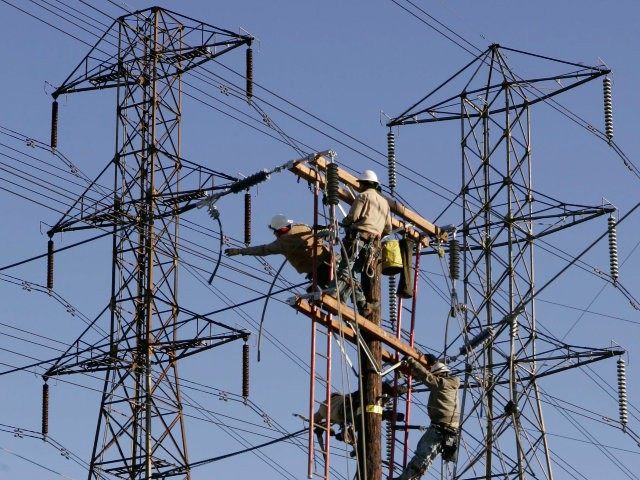By doubling the percentage of electric power generation that must be “renewable” by 2020 to 33 percent, California–with the highest poverty rate in the nation–will continue paying the highest utility rates in the nation.
Solar costs 6 times and wind costs 4.5 times more than natural gas power, because the sun doesn’t always shine and the wind doesn’t always blow. But this stupid economic disadvantage–subsidized by the poor–may become less stupid as new smart battery storage could level out renewable production availability.
The California Independent System Operator (ISO), which manages the flow of electricity across the high-voltage long-distance power lines for 80 percent of California’s power grid, realized on a bright and windy Sunday morning last April that wind and solar facilities were generating more power than the grid’s 30 million customers could absorb. The ISO ordered a 90-minute throttle-down of 1,142 megawatts from inflexible renewable energy plants and let flexible fossil fuel plants keep the energy flow stable.
California continues to be the U.S. manufacturing capital, but the state’s lead is shrinking fast due to wildly rising energy costs. In the five years since the recession ended in 2010, the Golden State is only seventh among the top ten industrial states for job growth at 0.6 percent. Despite American manufacturing’s re-shoring renaissance since 2010, California only attracted 1.1 percent of America’s manufacturing expansion.
This period of weak manufacturing growth tracks directly to Governor Jerry Brown’s renewable energy initiatives, which pushed California’s commercial and industrial electrical costs to the highest in the continental U.S. at 11.9 cents per kilo-watt hour. Given that manufacturing energy costs average about 150 percent more than labor costs nationally, that explains why manufacturers concerned with competitive costs are avoiding California.
Since 2010, California’s stalled-out manufacturing helped the state to achieve the highest poverty rate in America at 16.8 percent. The City of Los Angeles has also captured the booby-prize as America’s Poorest Big City, with a poverty rate at 17.6%, according to an analysis of Census Bureau data by the American Community Survey-based.
Despite the job needs of the poor, Brown has mandated a doubling of California’s percentage of “renewable” electric power from 18.8% to 33% over the next five years, and wants half the state’s power coming from renewable sources by 2030.
But in a remarkable acknowledgement of the reality of green power’s lack of 24/7 availabilit (unlike fossil fuels), Brown addressed the problem in a recent Sacramento speech: “You get a lot of energy in certain parts of the day, and you have so much electricity you can’t use it. So you have to do something with it. You need storage.”
To achieve Brown’s goals, California’s three largest utilities are investing billions of dollars to bring hundreds of megawatts of storage on-line over the next several years. Utilities are experimenting with industrial-sized batteries and tanks of compressed air in the hunt for the best way to hold an electrical charge, as power supply usage rises and falls during the day and seasonal weather factors change renewable availability.
An example is a PG&E demonstration site in Vacaville that received $3.3 million from the California Energy Commission for two 20 foot high rectangular boxes housing huge battery packs. The facility can store 2 megawatts of electricity, about enough to sustain the power needs for 1,400 homes for 24 hours.
Given that tens of thousands of megawatts flow through California’s electricity grid to serve 30 million people every day, PG&E’s director of transmission asset management and regulatory strategy, Jon Eric Thalman, commented about that the beta battery test site: “It’s a drop in the bucket. But it helps.”
Most observers expect the biggest winner from this next push in renewable power will be Tesla’s Gigafactory, now under construction in Nevada. Although the plant will supposedly make battery packs for electric cars (despite falling sales momentum), the real focus of the plant is producing huge industrial-scale battery hubs for California’s three largest utilities.
Last September, Nevada Governor Brian Sandoval signed a package of bills that gave Tesla Motors $1.3 billion in tax breaks and cash as reward for building its $5 billion Gigafactory in his state. Assuming that the Tesla Gigafactory actually hires its estimate of 3,250 Nevada residents, the state subsidy per job will be $1,538,000.
The good news for California’s poor is that Nevada will be subsidizing part of California’s renewable expansion. From a manufacturing standpoint, battery packs could reduce the renewables cost disadvantage by up to 20 percent versus natural gas.
This marginal improvement still makes California’s commitment to renewable energy seem stupid from an economic investment standpoint. But at least California can celebrate that using smart batteries to store excess power during low peak periods qualifies as less stupid.

COMMENTS
Please let us know if you're having issues with commenting.